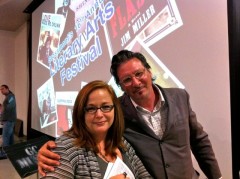

Sydney Brown, Grossmont's Literary Arts Festival organizer, with Gregory Page
Local singer-songwriter, and friend of the Troubadour, Gregory Page recently played at Grossmont College’s Literary Arts Festival, proving that music and the written word are indeed compatible. Now in its 16th year, Grossmont’s Literary Arts Festival continues to grow. (This year, it featured world-acclaimed author Sandra Cisneros.) And, while the emphasis continues to be the written word, the Festival provides ample room for music, mixed media, impromptu open mic performances, and student showcases.
The punch line to all of this is that every reading, every performance is absolutely free, thus providing the East County access to world-class art that normally would require a drive to L.A. and a handsome price for the cost of admission.
This is all thanks to California’s community college system, a network of 112 schools across the state, which, unfortunately, we often take for granted. Many of us have grown up with easy access to a nearby community college. Now, however, facing dire, drastic budget cuts, California’s community colleges may soon be dismantled so thoroughly that only skeletal vestiges will remain in a few years.
This will mean limited access for students. And, it could mean that events such as Grossmont’s Literary Arts Festival could become a thing of the past.
California’s community (or junior) college system was conceived over 100 years ago. Leading the nation (as California often does), the state established a network of community colleges by the 1920s. Whereas many states opted for colleges that were technical and vocational, California’s community colleges offered a full-range of educational opportunities, including liberal arts curricula usually reserved for private, four-year schools.
California’s community colleges continued to provide a cultural backbone as the state grew throughout the 20th century. Some of the older schools such as Pasadena City College, founded in 1924, and Santa Monica College, founded in 1929, helped shape popular entertainment due to their close proximity to Hollywood. Pasadena notes a long list of celebrities among its alumni, including Jackie Robinson, Kenny Loggins, Nick Nolte, and Eddie Van Halen. Santa Monica provided higher education for the likes of James Dean, Dustin Hoffman, Rickie Lee Jones, and Chad Ochocinco.
In San Diego County, the community college system grew much like it did throughout the state. What is now City College was established in 1914 yet it didn’t break ground on its current location until 1946. On its heels, Miracosta and Palomar Colleges were established in the ’30s and ’40s respectively as the county expanded, thanks to the Great Depression and then World War II. Grossmont, Southwestern, and Mesa were built in the suburbs during the Eisenhower years and the early 1960s. Today, there are five community college districts in the county with numerous satellite campuses added to buttress the colleges already mentioned.
Out of these colleges, many of our county’s professionals and leaders have made their way from high school to SDSU, UCSD, USD, and the various four-year institutions that call San Diego home. Our community colleges have also provided a platform for many entertainers and artists to fine-tune their craft. Tom Waits, Lester Bangs, Julieta Venegas, actor Adam Brody, former Padres GM Kevin Towers, Ozzy Osbourne guitarist Jake E. Lee, actor David Leisure, and probably half of the musicians reading this article have all entered and exited the halls of San Diego’s community college system.
So, in effect, our community colleges have filled the void left by the so-called “patrons of the arts” of centuries past. Whereas the arts communities and individual artists used to depend on the wealthy for financial support, the community colleges took over much of this responsibility by providing advanced classes in music, theater, visual arts, and media communications. In addition, the community colleges provided young, starving artists with multi-million dollar venues, stages, and production facilities not to mention myriad social networking avenues.
Certainly, a more in-depth study would show that our community colleges have had a profound impact on the American Arts.
Unfortunately, our beloved community colleges are in serious trouble now. For a collusion of reasons that the Left and the Right can tirelessly debate, the California community college system has pulled way back on the numbers and types of classes it now offers. The ongoing Great Recession has pushed the system over the budgetary edge. Now, severe cuts have meant the virtual elimination of summer school. So-called “luxury classes” such as literature and advanced studio classes have been ratcheted back. With the same pre-Recession numbers of students all scrambling to enroll in the reduced post-Recession class offerings, many classes are now out of reach for the average student.
In addition, countless part-time (or adjunct instructors), many of whom teach the specialty arts classes, have experienced wholesale layoffs while older tenured faculty and staff are being offered early retirement. If the situation continues, the community college system will soon fail to be that “patron of the arts,” that social platform for young artists that is so important.